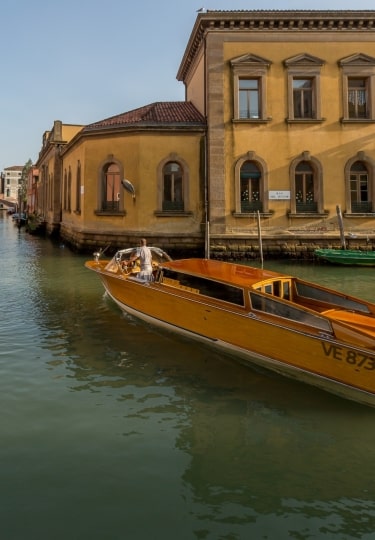Spread across 118 islands, floating in a misty lagoon and interconnected by more than 400 bridges, Venice is one of the world’s most beguiling cities. But what is Venice famous for? The list is a long one. Lavish palaces, the Grand Canal, gondolas, Casanova, and Carnival are just a few of the things that define this endlessly romantic place.
Despite all its big-hitting attractions, the “real” Venice is best discovered simply by getting lost. Just a few blocks from the main piazzas and watery thoroughfares, you can wander through narrow alleys, over tiny stone bridges, and into peaceful squares. Here, locals chat in coffee shops, fountains splash, and cats snooze on sunlit window ledges.
So combine your visit with some of the most famous sights, but make time to slow right down to appreciate this enchanting and unique place.
Basilica San Marco
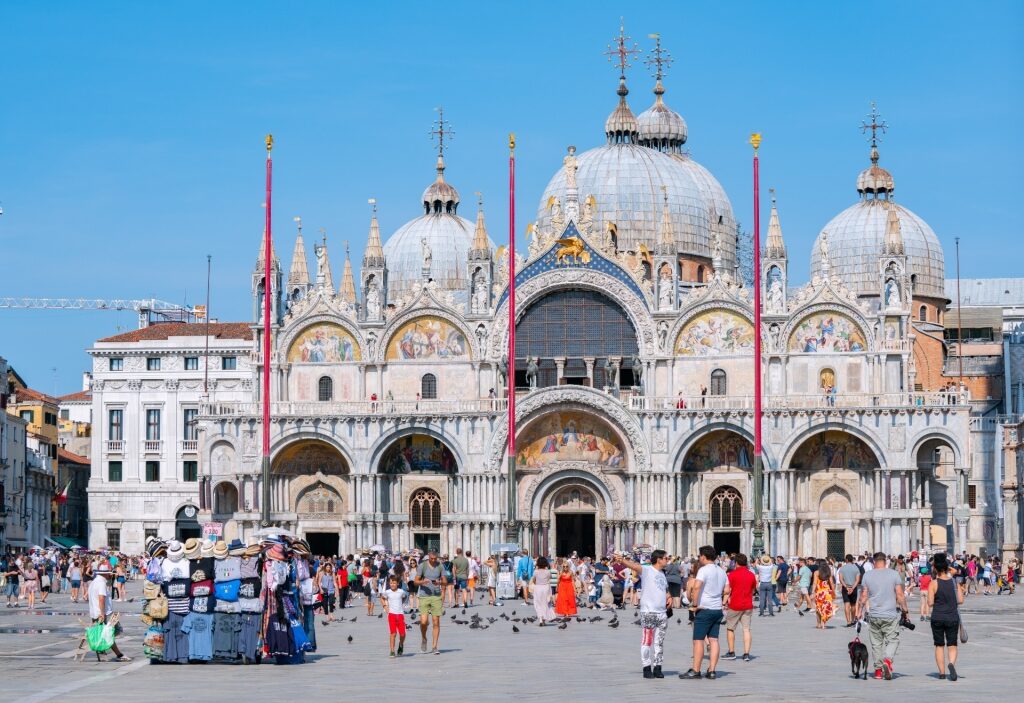
Basilica San Marco
Located next to the Doge’s Palace and dominating one side of the Piazza San Marco, this exquisitely beautiful basilica dates back to 829 AD. This structure was built to house the remains of St. Mark, now the patron saint of Venice. According to legend, the saint’s body was smuggled out of Egypt, hidden in a barrel of pork fat.
Although the original basilica was burned down, the version you see today was started in 1071. It’s distinctly Byzantine in style, topped with five domes, its footprint the shape of a cross. The walls are clad in marble from the Middle East and gold mosaics adorn the structure inside and out, causing its elaborate facade to glow in the sunshine.
Step inside this unique building and you’ll be awestruck by the beauty and detail of the thousands of mosaics, many adorned with gold leaf so the images they depict appear to shimmer. You can pay a small fee to see the sarcophagus in which St. Mark’s remains are preserved. It lies in the same section of the church as the priceless Pala d’Oro, a gold altarpiece glittering with precious stones like rubies, amethysts, emeralds, and sapphires.
The Doge’s Palace
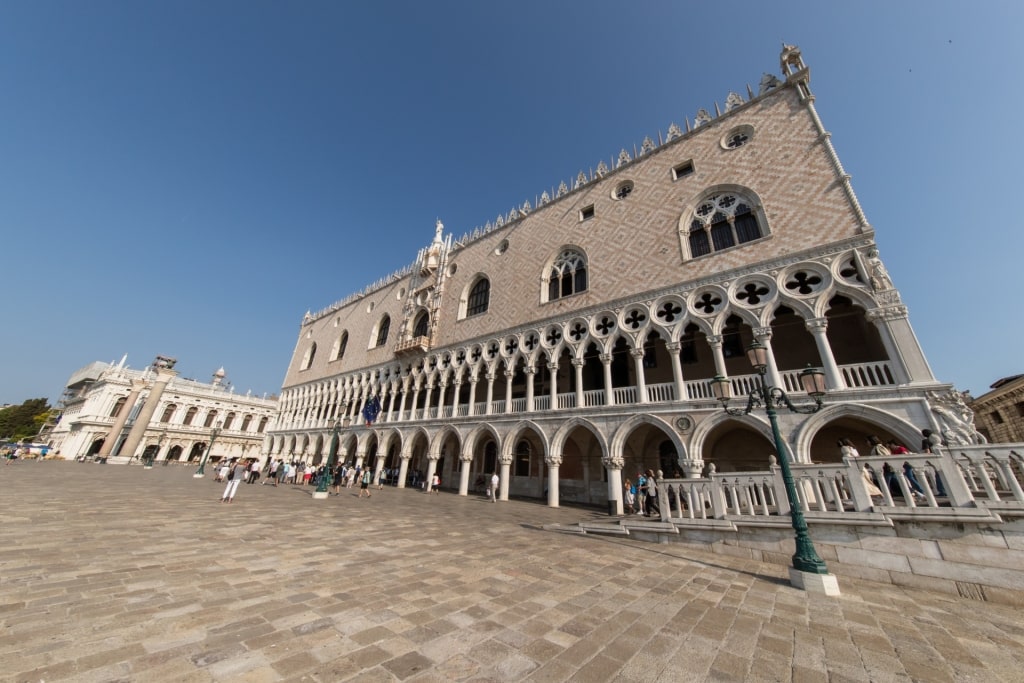
Doge’s Palace
Next to San Marco is the Doge’s Palace, or Palazzo Ducale, a pink-and-white Gothic fantasy encircled by graceful colonnades. The current version was started in the 14th century and was the official residence of the Doge and the seat of power of the mighty Venetian Republic, which was one of Europe’s great naval states for more than 1,100 years.
Inside, marvel at the Scala d’Oro, an opulent golden staircase, as well as the Doge’s private apartments, the armory, and the prison. There’s priceless art at every turn, including Tintoretto’s Paradise, one of the world’s largest paintings.
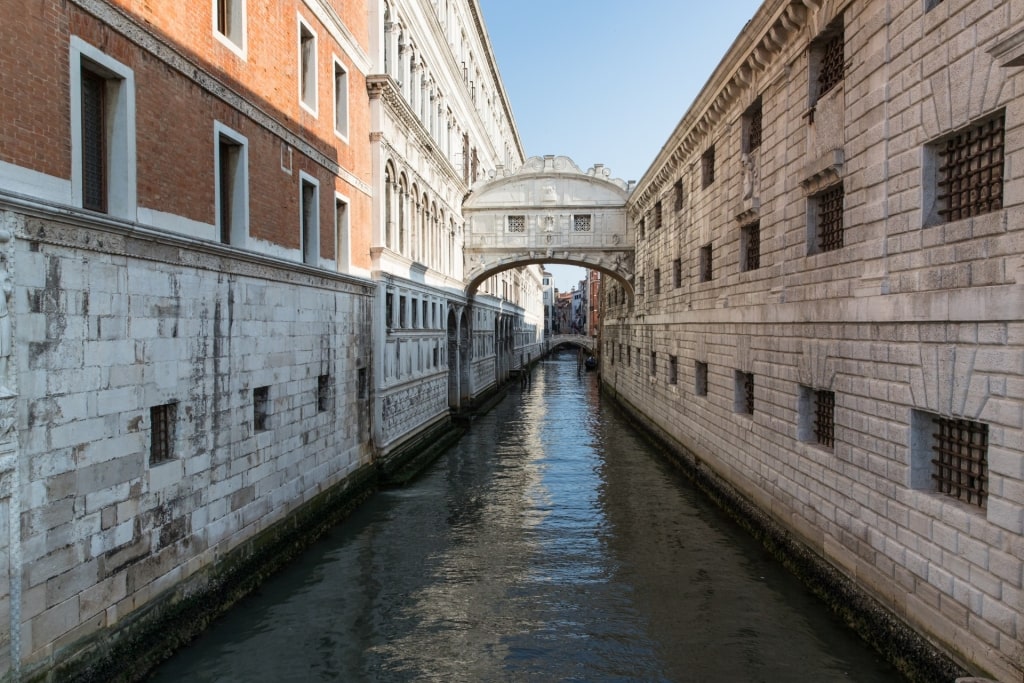
Bridge of Sighs
You’ll also see grim dungeons and prisoners’ cells. Prisoners would be led from the law courts in the palace to the cells over the baroque Bridge of Sighs, which spans the narrow Rio di Palazzo canal. The bridge was built in 1602 and is the only covered bridge in Venice. Its name comes from the assumption that prisoners would sigh in despair as they caught their last glimpse of the lagoon through the narrow windows.
There were further prison cells under the hot lead roofs, called the Piombi. This is where Giacomo Casanova, social commentator and legendary libertine, was imprisoned in 1755-56. Casanova was the only prisoner to escape the prison, via the roof with the help of the renegade priest in the neighboring cell. If you join a “Secret Itineraries” tour of the palace, you’ll be taken up to these cells.
Gondolas
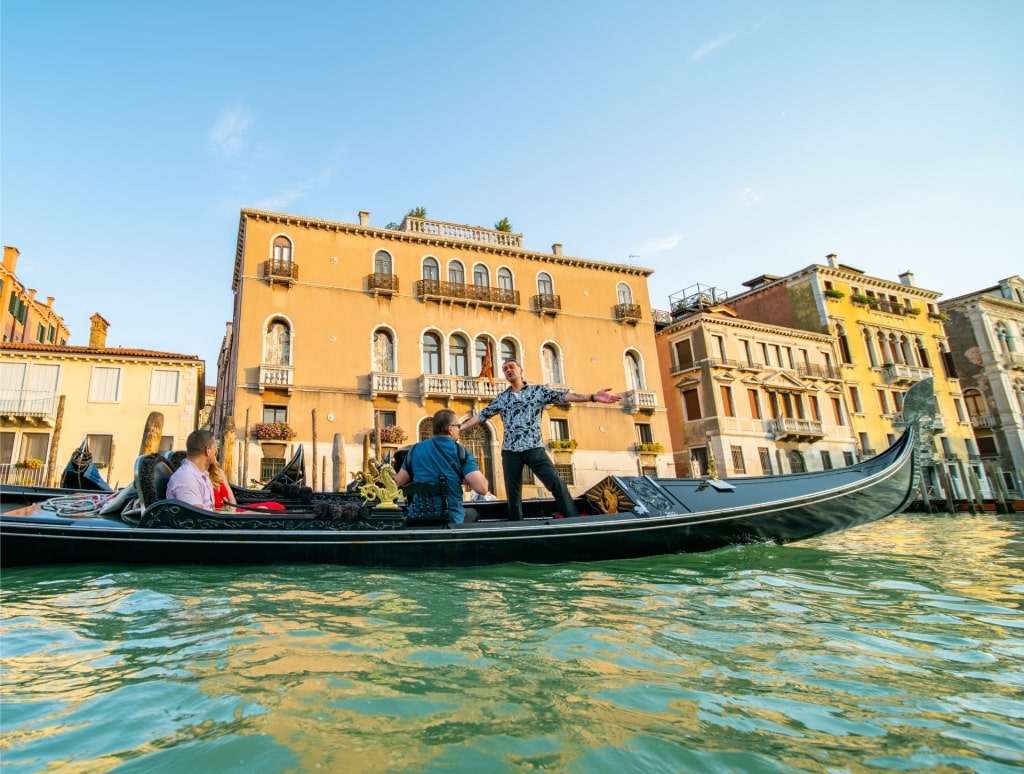
Gondola ride
Distinctive glossy black gondolas have plied the canals of the Italian coastal town of Venice since the 11th century. At various points in history, there were thousands of the flat-bottomed boats on the city’s canals, elaborately decorated and symbols of wealth. While only a few hundred are in operation today, taking a ride in one is something every visitor should try at least once.
The gondola is a work of art, its construction involving artisans from metalworkers to upholsterers and sculptors. Each boat is made of eight kinds of wood, including mahogany, oak, and walnut. The boats are asymmetrical, leaning slightly to the right, so the gondolier can stand on the left, or port side for balance. The fero, the iron prow, is shaped to depict multiple symbols of Venice, from the Rialto Bridge to the Doge’s cap and the islands of the lagoon.
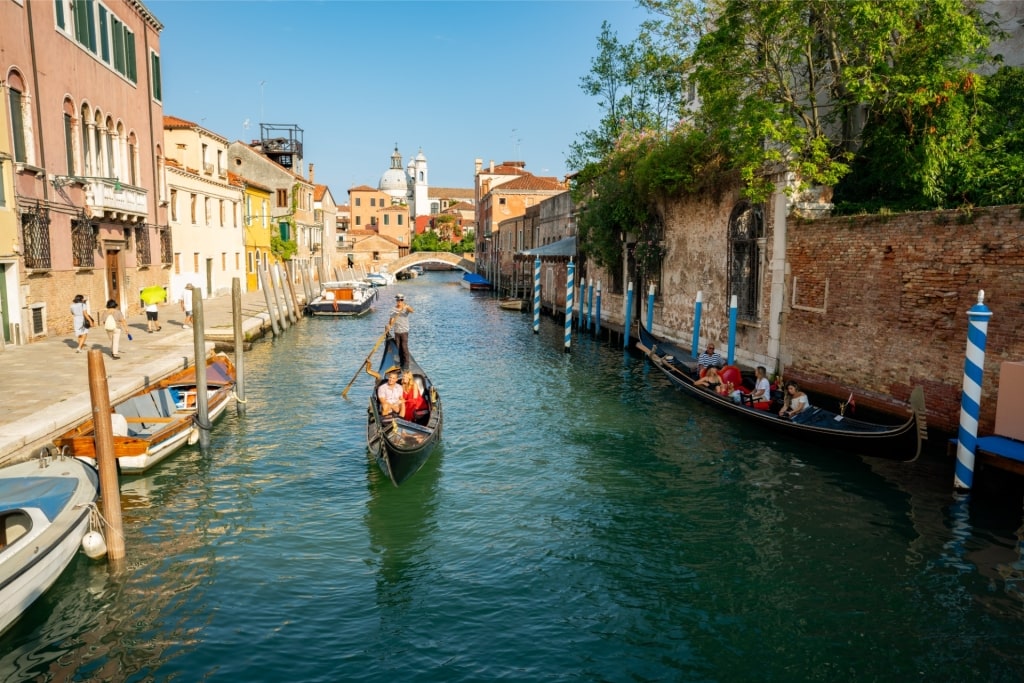
Gondola ride
Gondoliers are highly trained, tested in standing, rowing, and swimming before attending specialist school where they study Venetian history, culture, and foreign languages as well as rowing. Only 425 licenses are issued by the city, and each gondolier must buy and maintain their own boat and wear the standard uniform of dark pants and red or blue striped shirt.
A great way to get an insight into this age-old industry, the skills of which have been passed down through generations, is to visit a squero, or gondola maker, or which only a few remain. You’ll see boats being built and repaired, and learn about the history of this noble craft.
Carnival
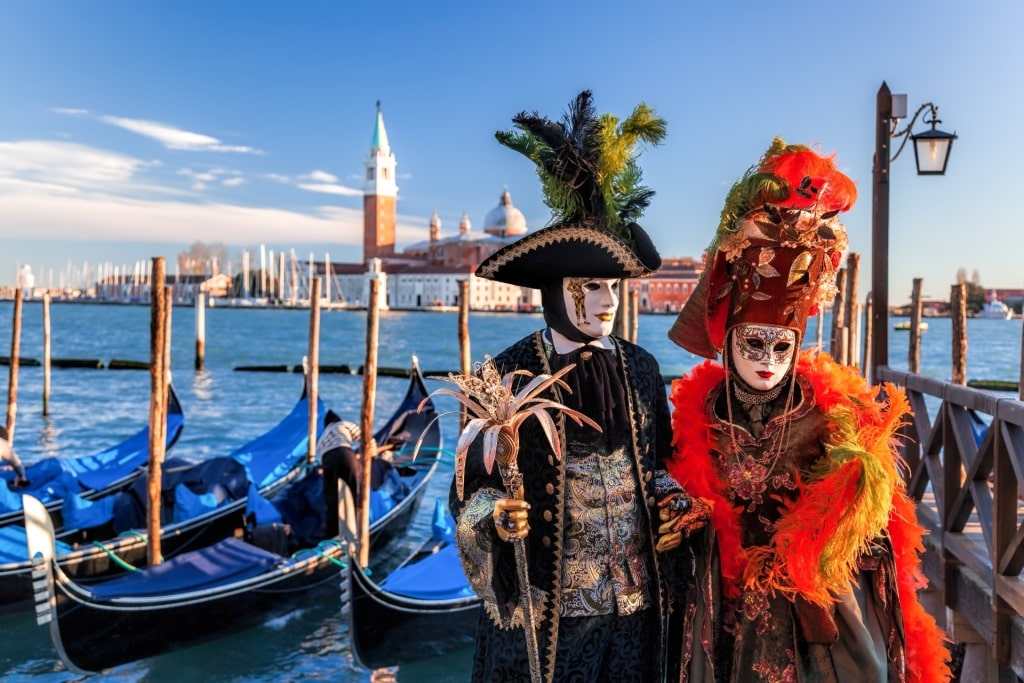
Carnival
The Venice Carnival is an annual, pre-Lenten bacchanale, originating in the Middle Ages. Carnival was abolished in 1797 but started up again in 1979. Now, it’s one of the most lavish celebrations of its kind in the world, attracting some three million visitors.
Carnival is a last blast of hedonism before the 40 somber days of Lent. The beautiful city comes alive with elaborate costumes, balls, parties, and ornate masks designed to protect an individual’s identity.
Even if you’re not in town for Carnival, you’ll see masks on sale everywhere. A good one can make a great souvenir to take home, whether you opt for porcelain, papier mache, or gold leaf.
Don’t buy a cheap knockoff from a street vendor; head to one of the mask-makers’ ateliers instead. Ca’Macana in the Dorsoduro neighborhood is one of the most famous, where you’ll learn all about the history and techniques of mask-making. You can even join in a workshop to decorate your own carnival mask, a great activity if you’re traveling in Venice as a family.
Read: Italy With Teens: Best Things to See & Do
The Grand Canal
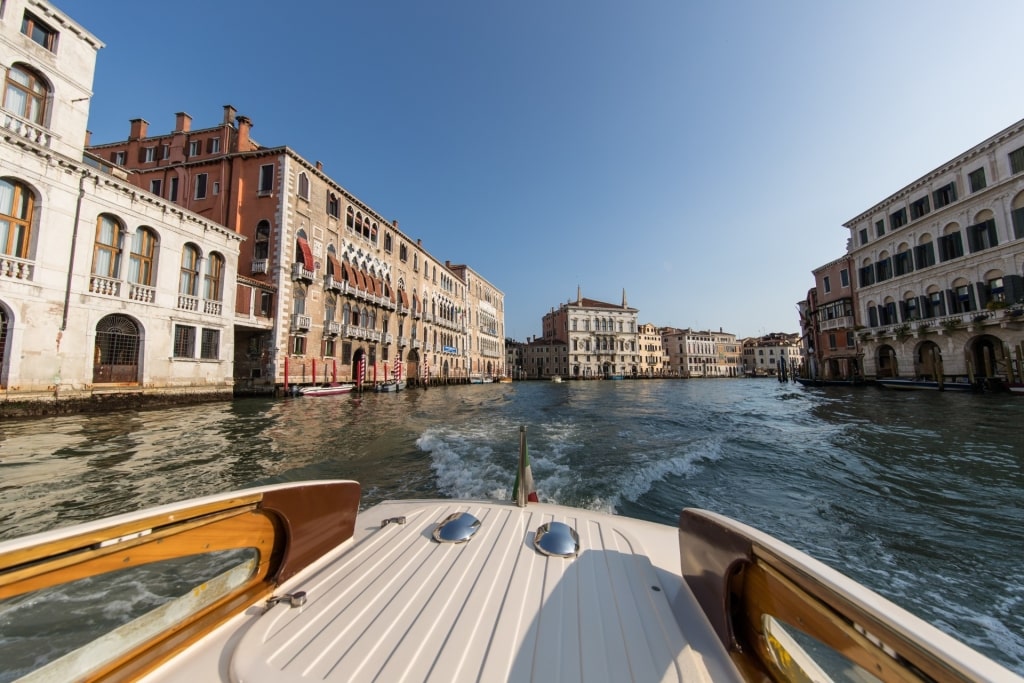
Grand Canal
Venice is known for its canals which crisscross the city. None, however, is more famous than the Grand Canal, one of the most romantic places in Italy.
The canal snakes through the center in an S shape, connecting San Marco with the Santa Chiara church. As there are no cars in the center of Venice, this is the principal transport artery.
The Grand Canal is just over two miles long. Take a waterside seat and you’ll see Venice encapsulated in the craft that glide past you. In the mornings, the canal is abuzz with delivery barges bringing produce to the Italian markets, shops, and restaurants. Vaporetti, or water buses, chug up and down, laden with locals and visitors. There are police, fire, and ambulance boats, funeral boats, glossy Riva water taxis, and, of course, gondolas.
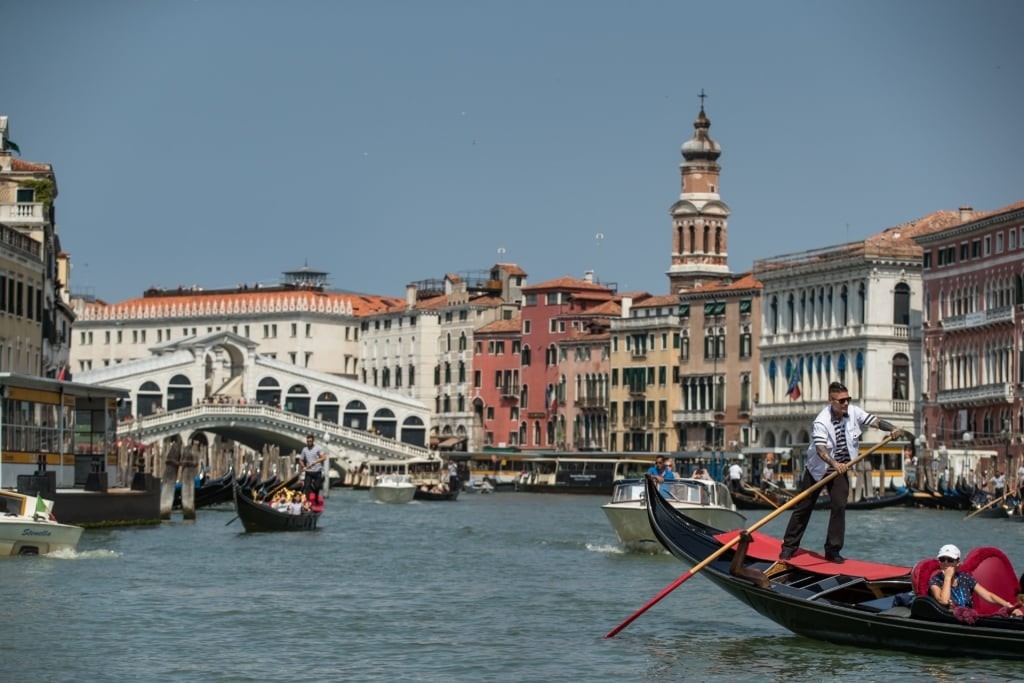
Grand Canal
The canal is lined with glorious old palaces in shades of ochre and dusky pink that make Venice one of the most beautiful cities in the world. The best way to see it, if you don’t want to ride a gondola, is aboard the No. 1 Vaporetto route, which takes you the length of the canal. Try to pick a time of day that’s not too busy for the best views, as the vaporetti can get pretty crowded.
Harry’s Bar

Harry’s Bar
For many, a Bellini cocktail—prosecco with peach puree—at the legendary Harry’s Bar, where the drink was invented, is an essential element of the Venice experience.
Harry’s Bar was opened by Giuseppi Cipriani Senior in 1931 on Calle Vallaresso near San Marco. Its starry lineup of guests ranged from Orson Welles to Ernest Hemingway. It was, and is, the epitome of European café culture, with its mahogany tables and sultry lighting.
The bar is actually an unassuming place with a discreet entrance, and it’s fun to say you’ve had a drink here. Don’t expect to make videos for social media, though; Harry’s is not that kind of place.
The Rialto Bridge

Rialto Bridge
The elaborate Rialto Bridge, its Istrian stone gleaming white in the sunshine, is one of the most iconic images of Venice. Originally, this was a wooden bridge, the current stone iteration having been completed in 1588 and connecting the neighborhoods of San Polo and San Marco.
Photograph the bridge from the water, wander across to browse the craft and souvenir stalls that line it, and take time to explore the surrounding squares and alleys.
On the western side, there’s a wonderfully colorful fruit, vegetable, and fish market where locals shop. This is a great place to stop for coffee or gelato, or pick up a snack, especially when peaches are in season. Bear in mind that you’re only allowed to picnic in the parks in Venice, not the streets and squares.
Cicchetti
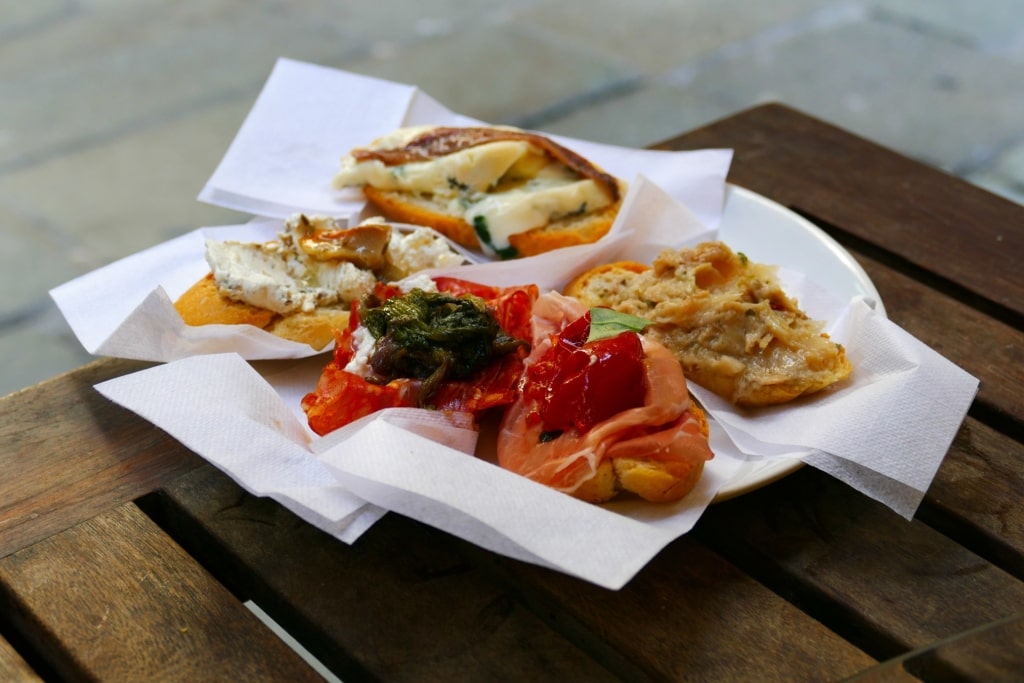
Cicchetti
If you’re looking to try Venice’s incredible cuisine, cicchetti is the city’s answer to Spanish tapas. You’ll find them all over the city in every neighborhood bácaro, a small, usually dimly lit wine bar.
You select three or four cicchetti from a display at the bar to be enjoyed with your ombra, or small glass of wine. You’ll see people everywhere with bright orange Aperol spritz cocktails, too, which originated in Venice. Expect to find delicacies like salted cod balls, tiny sardines, crostini with different spreads, little croquettes of meat or tuna, artichoke hearts, and olives.
Read: Best Dishes in Italy
Art
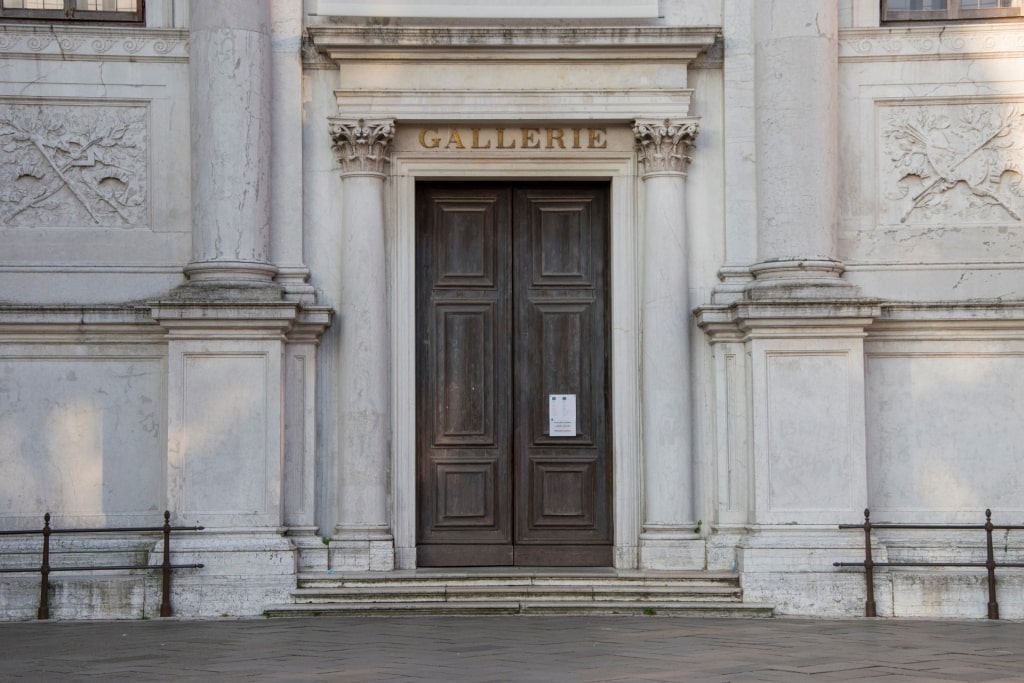
Gallerie dell’Accademia
Venice has some of the best art museums in Italy, with works spanning the centuries. Visit the Gallerie dell’Accademia at the end of the wooden Accademia Bridge for jaw-droppingly beautiful art, mainly depicting scenes painted in and around Venice from the 14th to the 17th centuries.
You’ll find an A-list lineup of Venetian artists here: Titian, Bellini, Tiepolo, Tintoretto, and Canaletto. Wandering the rooms is like stepping back in time to an era when Venice was a republic and a bustling center of trade.
There’s fine contemporary art at the Peggy Guggenheim Collection, housed in a palazzo on the Grand Canal where the art collector lived for many years. You can see Peggy’s personal collection of European and North American art, which includes works by Magritte, Picasso, Dalí, and Klee, among many others.
Make time to wander around the serene sculpture garden. There’s an impressive calendar of temporary exhibitions in addition to the permanent collection.
Murano Glass
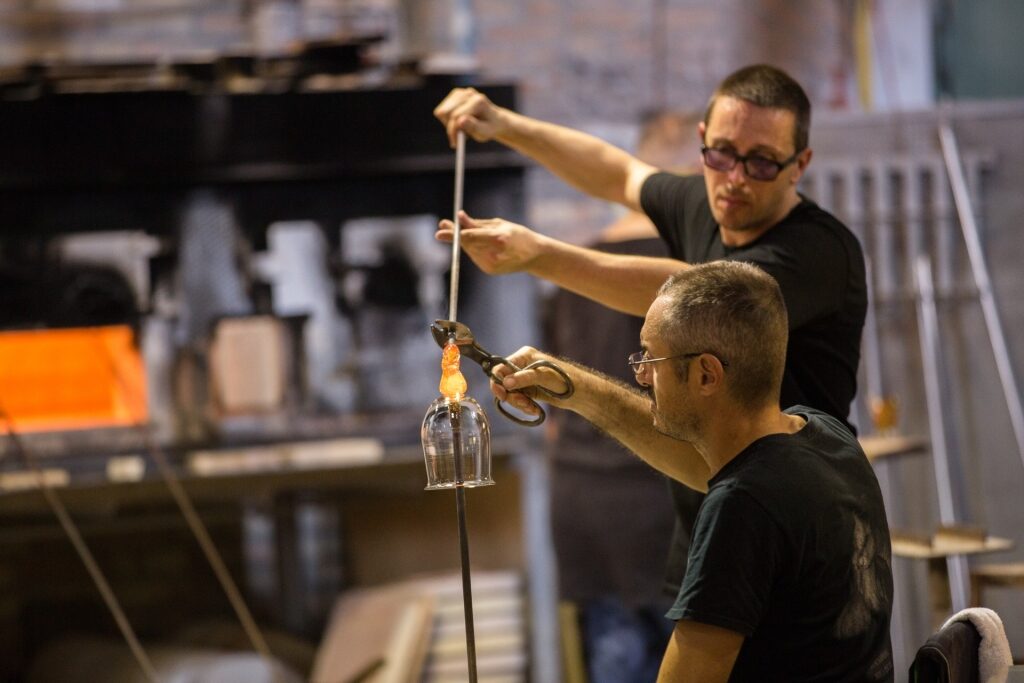
Murano glass
The pretty island of Murano, lying in the Venice lagoon, is easily reached by vaporetto. Murano is only 10 minutes away, a miniature Venice complete with canals and lavish palazzos.
What Murano is really famous for, though, is its glass-blowing tradition. You can get some background on the history of glass blowing, which originated in the Middle East, at the Museo del Vetro, the small glass-blowing museum. Glass blowers’ studios are everywhere; be sure to take in a demonstration and you’ll come away with a new appreciation of this delicate art. Some even offer lessons.
Then there’s the chance to buy anything from glass earrings to tableware, ornaments, and lavishly beautiful chandeliers; you’d have to have the latter shipped home, of course. You’ll find better quality here than in the mass-market shops in central Venice.
Burano Lace
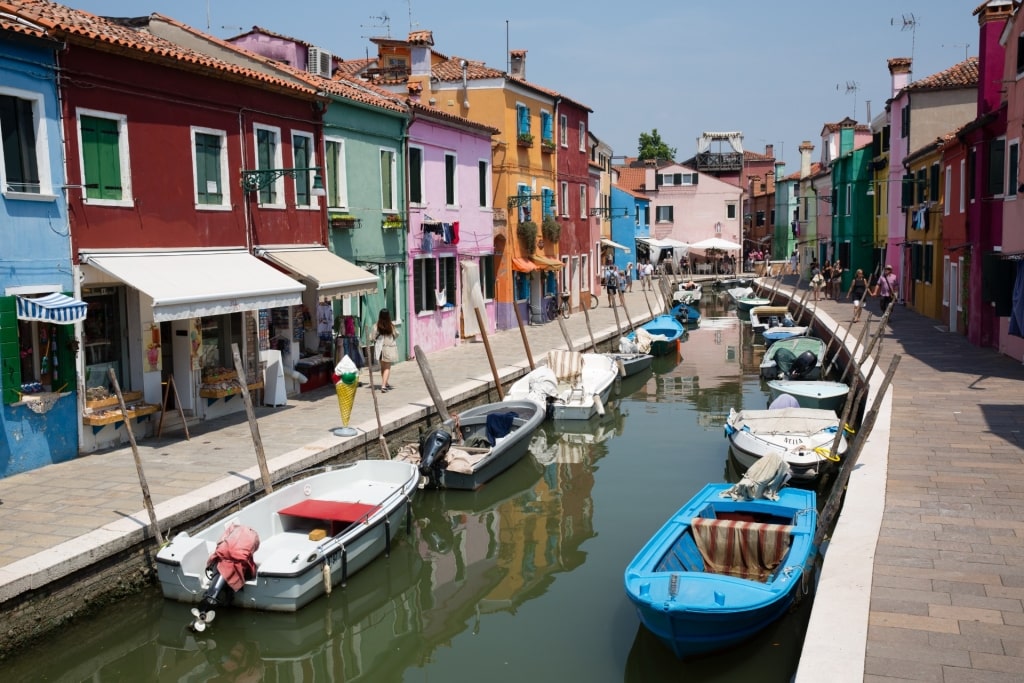
Burano
Another island in the lagoon, Burano, is a 45-minute vaporetto ride from Venice and a worthy half-day trip. The tiny fishing town is crammed with cottages in vibrant shades of hot pink, orange, lime green, and sunshine yellow. Local lore suggests that fishermen painted their houses in such bright colors so they could see them from a distance while out on the mist-shrouded lagoon.
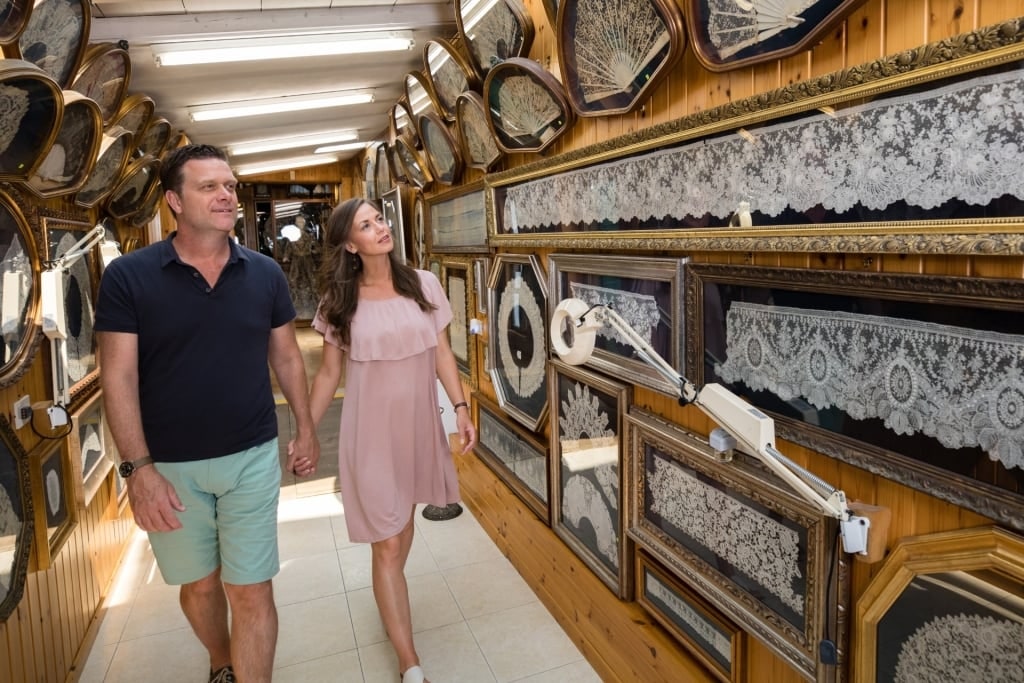
Lace shop in Burano
Burano is the place to go for lace, which is woven by local women in a tradition that’s been handed down through generations. Don’t be surprised to be invited into a home or shop to admire the handicrafts.
And while you’re here, stop for lunch; the local specialty is risotto de gò, a creamy risotto in which the rice is cooked in a stock made from the goby, a fish that’s common in the lagoon.
The Acqua Alta Bookstore
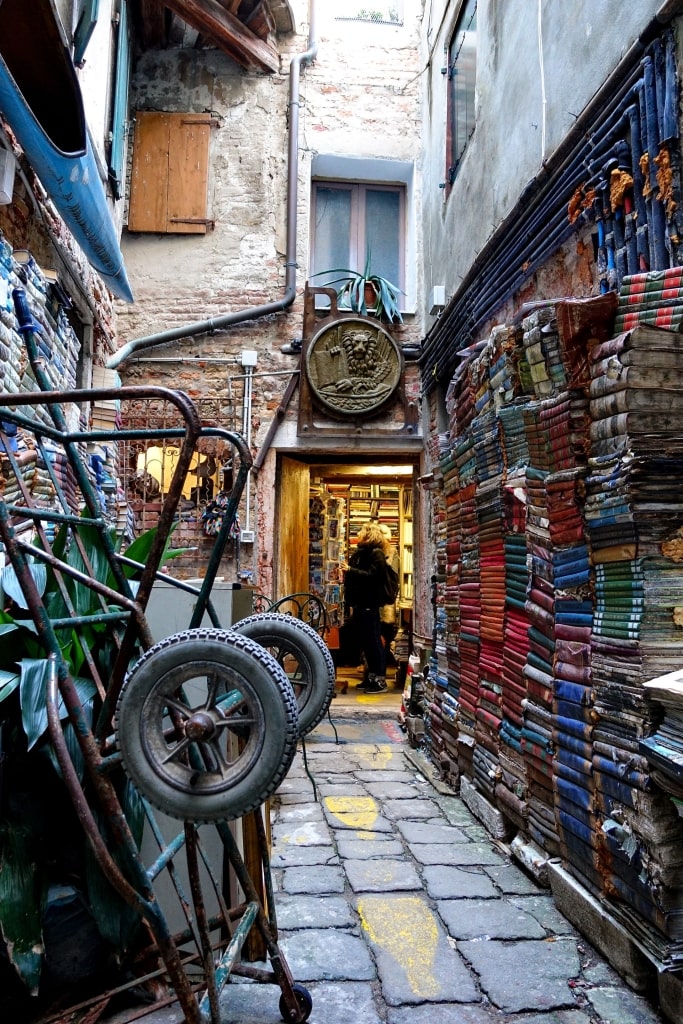
Acqua Alta Bookstore
The Libreria Acqua Alta is a bookstore like no other, located directly on a canal in the Castello neighborhood. As Venice is prone to extreme high tides, or aqua alta, the books are stashed not only on shelves but also in gondolas, canoes, and tanks.
Access this quirky store by clambering up a staircase made of books. Despite the apparently chaotic display, there’s a sense of serenity here, the bookstore guarded by Venetian cats which bask on the sunny windowsills and sometimes, on top of piles of books. It’s a wonderful taste of the lesser-known side of Venice.
Read: One Day in Venice

Gondola ride
Are you ready to be seduced by Venice? Browse our cruises to Venice and plan your European adventure.
